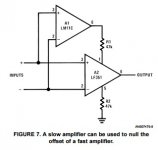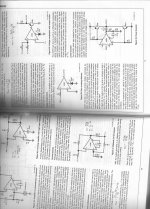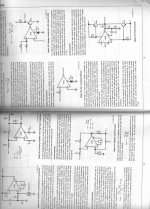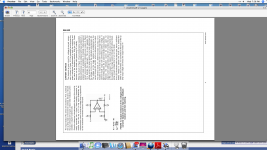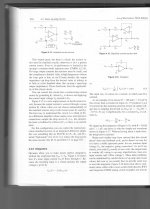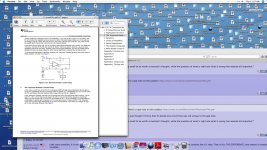There has been DRAMA in IC linear amp design. Most of it was with Bob Widler making the first real breakthroughs in making a practical IC op amp. Many of his inventions, especially in device fabrication, are what made the vast majority of linear IC's even possible. He was my hero in the 1960's.
It is true that 'drama' in audio design today is mostly due to marketing, but why blame the designers for the marketing? Usually they are separate groups of people. Personally, my reluctance for marketing and advertising with my Vendetta products is often put to me for the lack of great financial success of the company back around 1990. I still would not done it any other way.
For example, if our friend and fellow designer, Nelson Pass puts a pretty young woman in an ad for one of his products, does that reflect on Nelson? No, if it helps to promote a product successfully, yet it adds 'drama'.
It is true that 'drama' in audio design today is mostly due to marketing, but why blame the designers for the marketing? Usually they are separate groups of people. Personally, my reluctance for marketing and advertising with my Vendetta products is often put to me for the lack of great financial success of the company back around 1990. I still would not done it any other way.
For example, if our friend and fellow designer, Nelson Pass puts a pretty young woman in an ad for one of his products, does that reflect on Nelson? No, if it helps to promote a product successfully, yet it adds 'drama'.
Input transformer with a shield between primary and secondary.
Yes.
I thought it was counterpoint and Mark Levinson who used to use suggestive shots in their adverts? Nelson uses himself (with that santa in off season look he has spent decades perfecting) 🙂
There has been DRAMA in IC linear amp design. Most of it was with Bob Widler making the first real breakthroughs in making a practical IC op amp.
I thought the drama was bringing in a goat to "mow" the lawn, keeping an ax in his office, and other things best left unmentioned.
For me, it was his spending his 'free time' proving better ways of using IC processing that was primarily digital at the time, for making 'op amps'. Then, later, moving from Fairchild to National because they would not give him the salary increase that he deserved.
I got my first Widlar IC op amps, the uA702 and uA709 more than 50 years ago from a girlfriend who worked on the Fairchild assembly line. They were worth something like $100ea at the time. From relatives who worked at Fairchild and National, the latest engineering binders that put me ahead of most regular engineers at the time. Then I spent 9mo extensively evaluating a number of uA709's for a military project, noting that TI had gotten into the action. I didn't really design professionally with linear IC op amps until 1969, where I found the uA741 a 'breakthrough' for servo designers, but still a bit slow for quality audio. Still, I studied every circuit and app note that I could find on IC's and still do to this day, more or less. I initially had high hope for linear IC's, but I have had to stick to discrete, so far, for my best efforts.
I got my first Widlar IC op amps, the uA702 and uA709 more than 50 years ago from a girlfriend who worked on the Fairchild assembly line. They were worth something like $100ea at the time. From relatives who worked at Fairchild and National, the latest engineering binders that put me ahead of most regular engineers at the time. Then I spent 9mo extensively evaluating a number of uA709's for a military project, noting that TI had gotten into the action. I didn't really design professionally with linear IC op amps until 1969, where I found the uA741 a 'breakthrough' for servo designers, but still a bit slow for quality audio. Still, I studied every circuit and app note that I could find on IC's and still do to this day, more or less. I initially had high hope for linear IC's, but I have had to stick to discrete, so far, for my best efforts.
Last edited:
There has been DRAMA in IC linear amp design. Most of it was with Bob Widlar making the first real breakthroughs in making a practical IC op amp. Many of his inventions, especially in device fabrication, are what made the vast majority of linear IC's even possible. He was my hero in the 1960's.
It is true that 'drama' in audio design today is mostly due to marketing, but why blame the designers for the marketing? Usually they are separate groups of people. Personally, my reluctance for marketing and advertising with my Vendetta products is often put to me for the lack of great financial success of the company back around 1990. I still would not done it any other way.
For example, if our friend and fellow designer, Nelson Pass puts a pretty young woman in an ad for one of his products, does that reflect on Nelson? No, if it helps to promote a product successfully, yet it adds 'drama'.
For me, it was his spending his 'free time' proving better ways of using IC processing that was primarily digital at the time, for making 'op amps'.
He had some boners too, he hated FET's so much he did the LM11. Do you think many folks actually used some of the applications here (I said many not any)? http://www.ti.com.cn/cn/lit/an/snoa818/snoa818.pdf
Though I do like the no cap offset servo taking advantage of its inherent slowness.
Attachments
Last edited:
Well Scott, on page 9 of the App note that put up, I USED that brilliant floating current source design to make a 2000W servo amp for Ampex Research in 1969. When I offered this design to RG Meyer at UC Berkeley as an alternative current source, he looked at it with some question. Still, it works, and I later used it for the record drivers for both the Mobility Fidelity and Wilson Audio 30 ips recorders, after first designing it into an HK prototype cassette tape recorder in 1978. App notes can be VERY USEFUL if you keep an open mind about NIH, that is inherent in all of us.
Here are the 2 major apps that I took from Widlar, back in the late 60's. In fact, I saw them in an earlier app note, or an engineering mag article, before early 1969, because I used the current source app. in mid 1969, then I used the power amp app in 1970 as an automotive power amp, and even a temporary power amp for one of my K-horns.
Attachments
App notes can be VERY USEFUL if you keep an open mind about NIH, that is inherent in all of us.
Funny you should say that, the Howland current source was definitely not invented there.
The "Basic Howland Current Pump" was invented by Prof. Bradford Howland of MIT, about 1962, and the
invention was disclosed to his colleague George A. Philbrick (the analog computer pioneer who was head
of Philbrick Researches, Boston MA at that time). This circuit was not patented. The Howland Current
Pump was first published in the January 1964 "Lightning Empiricist", Volume 12, Number 1.
That looked like an "improved" Howland Current Pump that I saw there. Here's a app note on the subject: http://www.ti.com/lit/an/snoa474a/snoa474a.pdf
That looked like an "improved" Howland Current Pump that I saw there. Here's a app note on the subject: http://www.ti.com/lit/an/snoa474a/snoa474a.pdf
The first note simply said "classic" op-amp current source with no attribution, just thought it funny that JC picked one circuit that was not unique to the app note.
Look more carefully, it is not a Howland current source as described in 'The Art of Electronics' pp. 229-230. It has an EXTRA resistor that controls the V:I ratio. That is ALL THE DIFFERENCE, that makes it exceptionally versatile.
Attachments
Last edited:
Look more carefully, it is not a Howland current source as described in 'The Art of Electronics' pp. 229-230. It has an EXTRA resistor that controls the V:I ratio. That is ALL THE DIFFERENCE, that makes it exceptionally versatile.
The improved was dropped from improved Howland current source for as long as I can remember. The point was that app note was not the first appearance.
I am talking about almost 50 years ago! Not the last 20 years. Scott, I think you were not designing circuits when this first came out and I grabbed it. I don't care if Bob Widlar designed it, some colleague at Fairchild did, or some professor: I saw that it was an elegant solution to a making a floating current source, for motor drives, or even analog record amps. It was not in general textbooks at the time (late 60's) so far as I know. The standard Howland Current pump was in the textbooks at the time (I'm pretty sure).
Attachments
Is there a point to this I was first no I was first?
Jeez.
Jan
You didn't attribute I to Ampere!

Last edited:
- Status
- Not open for further replies.
- Home
- General Interest
- Everything Else
- What is wrong with op-amps?
